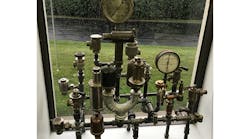Latest from Hydronics
Sponsored
The reports of my retirement have been greatly exaggerated. A few Monday mornings ago, the first three guys I talked to thought I was retiring soon. Loose lips were waggling, but it was misinformation, like you can find on the internet.
My current plan is to work four more full-time heating seasons before semi-retirement. So, when CONTRACTOR asked me to take over the hydronics desk, I figured I could have five years or so of trying to show you how you can make wet heat profitable. One, by being smarter about what’s out there. Two, by keeping up with the changes. If history tells us anything, things don’t stay the same for long.
The hydronics industry has changed over the last 35 years I’ve been in the wholesale distributor side of it. High efficiency used to be spark ignition and a vent damper. Maybe add an indoor/outdoor reset control—but don’t let the flue gasses condense. High efficiency now wants as much flue gas condensation as possible. Say goodbye to by-pass piping, boiler protection valves, minimum water temperatures, etc. The mod-con’s love the cool return water temperatures that determine boiler efficiency. What was once considered bad is now considered good. I didn’t see that coming.
I am honored and humbled to be a national voice for an industry that has been very good for me. There is a lot to learn to be a successful contractor and I will try to use this column to help you recognize that next thing you find down in the basement. You’re usually not there because it works. If you know what it is and how it is supposed to work, you’re going to get the contract to fix or replace it.
My time lately, and for the next four or so years, is being used to train my replacement. He goes to job sites with me to see what this hydronics stuff is all about. I point and speak. He nods and says very little. This process has reminded me of the importance of explaining how and why things work or fail. Maybe he’s picking it up, maybe not. Now you’ll get to join in on the fun.
The power of knowledge is the best tool in your bag. It doesn’t break, and you can take it anywhere. I learned the wet side of the heating industry by going to industry schools and fixing systems in the field, early on with manufacturer’s reps who were kind enough to share their knowledge. However, I got my enthusiasm for hydronics from industry magazines that showed up in the mail. They promoted new concepts and new products that would make hydronics systems better. I was paying attention because I was going out there to fix these hot water or steam boilers systems and contractors were asking me what products or piping techniques to use. I needed to get smarter to do my job better. By now I had two kids to put through college.
My true passion ended up being the old steam systems. The history and technology of the golden age of steam, circa 1900 to 1930, intrigued me. I wrote a book for service techs to use in the field when working on a steam heating system back in 2003. It sold well, but now I pay it forward by offering an electronic version for free at steamupairoutwaterback.com. The accompanying photo is a display of traps, vents, and valves that have been graciously given to me by guys like you. (See anything interesting or that you donated?)
By now you are curious, like a car guy that wants to know what’s under the other guy’s hood, you want to know how I heat my house. Well, I won’t use brand names because I don’t want you to think I’m pitching anybody’s product. I want to stay out of those kinds of discussions. Let’s just talk technologies, not labels. Besides, the boiler isn’t even the brand I sell now.
I’m currently running a natural gas modulating-condensing (mod-con) hot water boiler with a fire tube heat exchanger to provide heat to an indirect fired water heater, a hot water coil in my first-floor air handler, and a six loop radiant ceiling in my second floor. I’ve lived in this house for 22 years and this is the third or fourth configuration. I’ve lost track.
Obviously, I like to try different things. With one system I heated the whole house (85,000 BTUs) through a ½” PEX line, just to prove it could be done. At that time, a single hot water coil with a pump, a variable speed injection pump, a hot boiler loop, and a high delta T kept us warm and toasty. And yes, it does get cold in Cincinnati where I live. What seems like the Bengals’ last playoff win, the 1981 AFC Championship Game or Freezer Bowl, was played in -9 degree F weather. Actually, their last playoff win was in 1988 during Norman Julius “Boomer” Esiason’s glory days. (Shout out to the Detroit Lions fans I met recently, who suffer more than most.)
Hydronics is not that much different here in the Midwest, just not as common as in other areas, like NYC, Boston, Chicago or Vail, Colorado. Steam heating is slowing fading away while hot water heating seems to be on the rise. I’ll talk about both while keeping it current to what I’m seeing in the field. Please feel free to contact me at [email protected] with any questions.
Next month we’ll get into this new concept of variable speed pumping. Oh wait, it is not so new, I was running a variable speed pump at my house 20 years ago. Guess I’ve been there…
Patrick Linhardt is a thirty-five year veteran of the wholesale side of the hydronic industry who has been designing and troubleshooting steam and hot water heating systems, pumps and controls on an almost daily basis. An educator and author, he is currently Hydronic Manager at the Corken Steel Products Co.
Patrick Linhardt
Patrick Linhardt is a forty-one-year veteran of the wholesale side of the hydronic industry who has been designing and troubleshooting steam and hot water heating systems, pumps and controls on an almost daily basis. An educator and author, he is currently Hydronic Manager at the Corken Steel Products Co.


